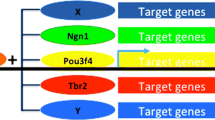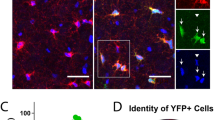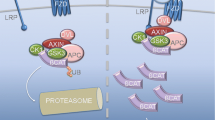Abstract
Oligodendrocyte development progresses from specification to terminal differentiation through several phases. By now, a number of transcription factors have been identified that are essential for one or more of these phases. They stem from transcription factor families with known roles in many developmental processes. Basic helix–loop–helix, homeodomain, and high-mobility-group containing transcription factors such as the Olig, Nkx, and Sox proteins have been particularly well studied. A complex picture has emerged in which these transcription factors interact in transcriptional networks and thereby combine and influence their respective activities as repressors or activators in such a way that stage- and cell-type specific gene expression is achieved during oligodendrocyte development.



Similar content being viewed by others
References
Arnett, H. A., Fancy, S. P., Alberta, J. A., Zhao, C., Plant, S. R., Kaing, S., et al. (2004). bHLH transcription factor Olig1 is required to repair demyelinated lesions in the CNS. Science, 306, 2111–2115.
Baas, D., Legrand, C., Samarut, J., & Flamant, F. (2002). Persistence of oligodendrocyte precursor cells and altered myelination in optic nerve associated to retina degeneration in mice devoid of all thyroid hormone receptors. Proceedings of the National Academy of Sciences of the United States of America, 99, 2907–2911.
Barres, B. A., Lazar, M. A., & Raff, M. C. (1994). A novel role for thyroid hormone, glucocorticoids and retinoic acid in timing oligodendrocyte development. Development, 120, 1097–1108.
Battiste, J., Helms, A. W., Kim, E. J., Savage, T. K., Lagace, D. C., Mandyam, C. D., et al. (2006). Ascl1 defines sequentially generated lineage-restricted neuronal and oligodendrocyte precursor cells in the spinal cord. Development, 134, 285–293.
Billon, N., Tokumoto, Y., Forrest, D., & Raff, M. (2001). Role of thyroid hormone receptors in timing oligodendrocyte differentiation. Developmental Biology, 235, 110–120.
Bondurand, N., Girard, M., Pingault, V., Lemort, N., Dubourg, O., & Goossens, M. (2001). Human Connexin 32, a gap junction protein altered in the X-linked form of Charcot-Marie-Tooth disease, is directly regulated by the transcription factor SOX10. Human Molecular Genetics, 10, 2783–2795.
Cai, J., Chen, Y., Cai, W. H., Hurlock, E. C., Wu, H., Kernie, S. G., et al. (2007). A crucial role for Olig2 in white matter astrocyte development. Development, 134, 1887–1899.
Cai, J., Qi, Y., Hu, X., Tan, M., Liu, Z., Zhang, J., et al. (2005). Generation of oligodendrocyte precursor cells from mouse dorsal spinal cord independent of Nkx6 regulation and Shh signaling. Neuron, 45, 41–53.
Deneen, B., Ho, R., Lukaszewicz, A., Hochstim, C. J., Gronostajski, R. M., & Anderson, D. J. (2006). The transcription factor NFIA controls the onset of gliogenesis in the developing spinal cord. Neuron, 52, 953–968.
Fogarty, M., Richardson, W. D., & Kessaris, N. (2005). A subset of oligodendrocytes generated from radial glia in the dorsal spinal cord. Development, 132, 1951–1959.
Fu, H., Qi, Y., Tan, M., Cai, J., Takebayashi, H., Nakafuku, M., et al. (2002). Dual origin of spinal oligodendrocyte progenitors and evidence for the cooperative role of Olig2 and Nkx2.2 in the control of oligodendrocyte differentiation. Development, 129, 681–693.
Genoud, S., Lappe-Siefke, C., Goebbels, S., Radtke, F., Aguet, M., Scherer, S. S., et al. (2002). Notch1 control of oligodendrocyte differentiation in the spinal cord. Journal of Cell Biology, 158, 709–718.
Gokhan, S., Marin-Husstege, M., Yung, S. Y., Fontanez, D., Casaccia-Bonnefil, P., & Mehler, M. F. (2005). Combinatorial profiles of oligodendrocyte-selective classes of transcriptional regulators differentially modulate myelin basic protein gene expression. Journal of Neuroscience, 25, 8311–8321.
He, Y., Dupree, J., Wang, J., Sandoval, J., Li, J., Liu, H., et al. (2007). The transcription factor Yin Yang 1 is essential for oligodendrocyte progenitor differentiation. Neuron, 55, 217–230.
Kamachi, Y., Uchikawa, M., & Kondoh, H. (2000). Pairing SOX off: with partners in the regulation of embryonic development. Trends in Genetics, 16, 182–187.
Kellerer, S., Schreiner, S., Stolt, C. C., Bösl, M. R., & Wegner, M. (2006). Functional equivalency of transcription factors Sox8 and Sox10 is tissue-specific. Development, 133, 2875–2886.
Kessaris, N., Fogarty, M., Iannarelli, P., Grist, M., Wegner, M., & Richardson, W. D. (2006). Competition waves of oligodendrocytes in the forebrain and postnatal elimination of an early embryonic lineage. Nature Neuroscience, 9, 173–179.
Kessaris, N., Pringle, N., & Richardson, W. D. (2001). Ventral neurogenesis and the neuron-glial switch. Neuron, 31, 677–680.
Kondo, T., & Raff, M. C. (2000). The Id4 HLH protein and the timing of oligodendrocyte differentiation. EMBO Journal, 19, 1998–2007.
Kuhlbrodt, K., Herbarth, B., Sock, E., Hermans-Borgmeyer, I., & Wegner, M. (1998). Sox10, a novel transcriptional modulator in glial cells. Journal of Neuroscience, 18, 237–250.
LeBlanc, S. E., Ward, R. M., & Svaren, J. (2007). Neuropathy-associated Egr2 mutants disrupt cooperative activation of myelin protein zero by Egr2 and Sox10. Molecular and Cellular Biology, 27, 3521–3529.
Liu, R., Cai, J., Hu, X., Tan, M., Qi, Y., German, M., et al. (2003). Region-specific and stage-dependent regulation of Olig gene expression and oligodendrogenesis by Nkx6.1 homeodomain transcription factor. Development, 130, 6221–6231.
Liu, Z., Hu, X., Cai, J., Liu, B., Peng, X., Wegner, M., et al. (2007). Induction of oligodendrocyte differentiation by Olig2 and Sox10: evidence for reciprocal interactions and dosage-dependent mechanisms. Developmental Biology, 302, 683–693.
Liu, A., Li, J., Marin-Husstege, M., Kageyama, R., Fan, Y., Gelinas, C., et al. (2006). A molecular insight of Hes5-dependent inhibition of myelin gene expression: old partners and new players. EMBO Journal, 25, 4833–4842.
Lu, Q. R., Sun, T., Zhu, Z., Ma, N., Garcia, M., Stiles, C. D., et al. (2002). Common developmental requirement for olig function indicates a motor neuron/oligodendrocyte connection. Cell, 109, 75–86.
Lu, Q. R., Yuk, D., Alberta, J. A., Zhu, Z., Pawlitzky, I., Chan, J., et al. (2000). Sonic hedgehog-regulated oligodendrocyte lineage genes encoding bHLH proteins in the mammalian central nervous system. Neuron, 25, 317–329.
Marin-Husstege, M., He, Y., Li, J., Kondo, T., Sablitzky, F., & Casaccia-Bonnefil, P. (2006). Multiple roles of Id4 in developmental myelination: predicted outcomes and unexpected findings. Glia, 54, 285–296.
Masahira, N., Takebayashi, H., Ono, K., Watanabe, K., Ding, L., Furusho, M., et al. (2006). Olig2-positive progenitors in the embryonic spinal cord give rise not only to motoneurons and oligodendrocytes, but also to a subset of astrocytes and ependymal cells. Developmental Biology, 293, 358–369.
Mizuguchi, R., Sugimori, M., Takebayashi, H., Kosako, H., Nagao, M., Yoshida, S., et al. (2001). Combinatorial roles of olig2 and neurogenin2 in the coordinated induction of panneuronal and subtype-specific properties of motoneurons. Neuron, 31, 757–771.
Nieto, M., Schuurmans, C., Britz, O., & Guillemot, F. (2001). Neural bHLH genes control the neuronal versus glial fate decision in cortical progenitors. Neuron, 29, 401–413.
Novitch, B. G., Chen, A. I., & Jessell, T. M. (2001). Coordinate regulation of motoneuron subtype identity and pan-neuronal properties by the bHLH repressor Olig2. Neuron, 31, 773–789.
Park, H. C., & Appel, B. (2003). Delta-notch signaling regulates oligodendrocyte specification. Development, 130, 3747–3755.
Parras, C. M., Hunt, C., Sugimori, M., Nakafuku, M., Rowitch, D. H., & Guillemot, F. (2007). The proneural gene Mash1 specifies an early population of telencephalic oligodendrocytes. Journal of Neuroscience, 27, 4233–4242.
Petryniak, M. A., Potter, G. B., Rowitch, D. H., & Rubenstein, J. L. R. (2007). Dlx1 and Dlx2 control neuronal versus oligodendroglial cell fate acquisition in the developing forebrain. Neuron, 55, 417–433.
Qi, Y., Cai, J., Wu, Y., Wu, R., Lee, J., Fu, H., et al. (2001). Control of oligodendrocyte differentiation by the Nkx2.2 homeodomain transcription factor. Development, 128, 2723–2733.
Richardson, W. D., Kessaris, N., & Pringle, N. (2006). Oligodendrocyte wars. Nature Reviews Neuroscience, 7, 11–18.
Rowitch, D. H. (2004). Glial specification in the vertebrate neural tube. Nature Reviews Neuroscience, 5, 409–419.
Samanta, J., & Kessler, J. A. (2004). Interactions between ID and OLIG proteins mediate the inhibitory effects of BMP4 on oligodendroglial differentiation. Development, 131, 4131–4142.
Schlierf, B., Werner, T., Glaser, G., & Wegner, M. (2006). Expression of Connexin47 in oligodendrocytes is regulated by the Sox10 transcription factor. Journal of Molecular Biology, 361, 11–21.
Sock, E., Schmidt, K., Hermanns-Borgmeyer, I., Bösl, M. R., & Wegner, M. (2001). Idiopathic weight reduction in mice deficient in the high-mobility-group transcription factor Sox8. Molecular and Cellular Biology, 21, 6951–6959.
Sohn, J., Natale, J., Chew, L. J., Belachew, S., Cheng, Y., Aguirre, A., et al. (2006). Identification of Sox17 as a transcription factor that regulates oligodendrocyte development. Journal of Neuroscience, 26, 9722–9735.
Soula, C., Danesin, C., Kan, P., Grob, M., Poncet, C., & Cochard, P. (2001). Distinct sites of origin of oligodendrocytes and somatic motoneurons in the chick spinal cord: oligodendrocytes arise from Nkx2.2-expressing progenitors by a Shh-dependent mechanism. Development, 128, 1369–1379.
Southwood, C., He, C., Garbern, J., Kamholz, J., Arroyo, E., & Gow, A. (2004). CNS myelin paranodes require Nkx6-2 homeoprotein transcriptional activity for normal structure. Journal of Neuroscience, 24, 11215–11225.
Stolt, C. C., Lommes, P., Friedrich, R. P., & Wegner, M. (2004). Transcription factors Sox8 and Sox10 perform non-equivalent roles during oligodendrocyte development despite functional redundancy. Development, 131, 2349–2358.
Stolt, C. C., Lommes, P., Sock, E., Chaboissier, M.-C., Schedl, A., & Wegner, M. (2003). The Sox9 transcription factor determines glial fate choice in the developing spinal cord. Genes and Development, 17, 1677–1689.
Stolt, C. C., Rehberg, S., Ader, M., Lommes, P., Riethmacher, D., Schachner, M., et al. (2002). Terminal differentiation of myelin-forming oligodendrocytes depends on the transcription factor Sox10. Genes and Development, 16, 165–170.
Stolt, C. C., Schlierf, A., Lommes, P., Hillgärtner, S., Werner, T., Kosian, T., et al. (2006). SoxD proteins influence multiple stages of oligodendrocyte development and modulate SoxE protein function. Developmental Cell, 11, 697–710.
Stolt, C. C., Schmitt, S., Lommes, P., Sock, E., & Wegner, M. (2005). Impact of transcription factor Sox8 on oligodendrocyte specification in the mouse embryonic spinal cord. Developmental Biology, 281, 323–331.
Sugimori, M., Nagao, M., Bertrand, N., Parras, C. M., Guillemot, F., & Nakafuku, M. (2007). Combinatorial actions of patterning and HLH transcription factors in the spatiotemporal control of neurogenesis and gliogenesis in the developing spinal cord. Development, 134, 1617–1629.
Sun, T., Dong, H., Wu, L., Kane, M., Rowitch, D. H., & Stiles, C. D. (2003). Cross-repressive interaction of Olig2 and Nkx2.2 transcription factors in developing neural tube associated with formation of a specific physical complex. Journal of Neuroscience, 23, 9547–9556.
Sun, T., Pringle, N. P., Hardy, A. P., Richardson, W. D., & Smith, H. K. (1998). Pax6 influences the time and site of origin of glial precursors in the ventral neural tube. Molecular and Cellular Neurosciences, 12, 228–239.
Taylor, M. K., Yeager, K., & Morrison, S. J. (2007). Physiological notch signaling promotes gliogenesis in the developing peripheral and central nervous systems. Development, 134, 2435–2447.
Vallstedt, A., Klos, J. M., & Ericson, J. (2005). Multiple dorsoventral origins of oligodendrocyte generation in the spinal cord and hindbrain. Neuron, 45, 55–67.
Wang, S. Z., Dulin, J., Wu, H., Hurlock, E., Lee, S. E., Jansson, K., et al. (2006). An oligodendrocyte-specific zinc-finger transcription regulator cooperates with Olig2 to promote oligodendrocyte differentiation. Development, 133, 3389–3398.
Wang, S., Sdrulla, A., Johnson, J. E., Yokota, Y., & Barres, B. A. (2001). A role for the helix–loop–helix protein Id2 in the control of oligodendrocyte development. Neuron, 29, 603–614.
Wegner, M. (1999). From head to toes: the multiple facets of Sox proteins. Nucleic Acids Research, 27, 1409–1420.
Wegner, M. (2000a). Transcriptional control in myelinating glia: flavors and spices. Glia, 31, 1–14.
Wegner, M. (2000b). Transcriptional control in myelinating glia: the basic recipe. Glia, 29, 118–123.
Wegner, M. (2005). Secrets to a healthy Sox life: Lessons for melanocytes. Pigment Cell Research, 18, 74–85.
Wegner, M., & Stolt, C. C. (2005). From stem cells to neurons and glia: a soxist’s view of neural development. Trends in Neurosciences, 28, 583–588.
Xin, M., Yue, T., Ma, Z., Wu, F. F., Gow, A., & Lu, Q. R. (2005). Myelinogenesis and axonal recognition by oligodendrocytes in brain are uncoupled in Olig1-null mice. Journal of Neuroscience, 25, 1354–1365.
Yamaguchi, H., Zhou, C., Lin, S. C., Durand, B., Tsai, S. Y., & Tsai, M. J. (2004). The nuclear orphan receptor COUP-TFI is important for differentiation of oligodendrocytes. Developmental Biology, 266, 238–251.
Zhou, Q., & Anderson, D. J. (2002). The bHLH transcription factors olig2 and olig1 couple neuronal and glial subtype specification. Cell, 109, 61–73.
Zhou, Q., Choi, G., & Anderson, D. J. (2001). The bHLH transcription factor Olig2 promotes oligodendrocyte differentiation in collaboration with Nkx2.2. Neuron, 31, 791–807.
Zhou, Q., Wang, S., & Anderson, D. J. (2000). Identification of a novel family of oligodendrocyte lineage-specific basic helix–loop–helix transcription factors. Neuron, 25, 331–343.
Acknowledgments
This work was supported by grants from the Deutsche Forschungsgemeinschaft (We1326/8-1 and SFB473), the Schram-Stiftung (T287/14172/2004), and the Fonds der Chemischen Industrie.
Author information
Authors and Affiliations
Corresponding author
Rights and permissions
About this article
Cite this article
Wegner, M. A Matter of Identity: Transcriptional Control in Oligodendrocytes. J Mol Neurosci 35, 3–12 (2008). https://doi.org/10.1007/s12031-007-9008-8
Received:
Accepted:
Published:
Issue Date:
DOI: https://doi.org/10.1007/s12031-007-9008-8




